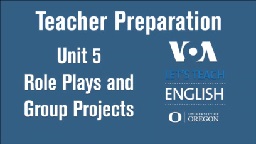|
|
| |
|
|
| |
|
|
|
|
| |
 Let's
Teach English Unit 5 Let's
Teach English Unit 5
The Let’s Teach English video series offers free online
training for English language educators worldwide. It is
based on the Women Teaching Women English text for
adult, beginning level learners. Voice of America and
the University of Oregon are partners on this project. |
|
|
|
Click to see the full PDF lesson -
opens in a new window. |
|
 Unit
5: Role Plays Unit
5: Role Plays
In this lesson, the teacher sets up a marketplace to use
in a shopping role-play. We join the class as the
teacher is reviewing common phrases for shopping
exchanges. Students separate into groups using a method
that requires them to talk with each other.
Students use new language in a authentic context through
their role-plays. The shoppers and shopkeepers have
different information. This creates a purpose for their
communication. |
Teacher Preparation Video
This episode shows a model of teaching through role plays and group
projects. |
|
 Video Transcript Video Transcript
Narrator: In this lesson, the teacher sets up a marketplace to use in a
shopping role play. We join the class as the teacher is reviewing common
phrases for
shopping exchanges. Students separate into groups using a method that
requires them to talk with each other. |
|
|
Teacher: Good morning, class.
Students: Good morning.
Teacher: So, we learned these expressions.
(The teacher points to a poster with shopping phrases on it.)
Teacher: Please say them with me: How much is . . .?
Students: How much is . . .?
Teacher: This costs . . .
Students: This costs . . .
Teacher: That’s too much.
Students: That’s too much.
Teacher: Thank you. And what do we call it when you ask for a lower price?
Julia: Bargain?
Teacher: Right, trying to lower the price is bargaining. Remember, in some
places
you cannot bargain. But today, in our market, we can have fun and
bargain. Please line up by the time you woke up this morning. Who woke
up early? Stand here.
(The teacher gestures to her left.)
Teacher: Who woke up later? Stand here.
(The teacher gestures to her right.)
(Students discuss what time they woke up and make a line in that order.)
Teacher: Okay, now let’s divide here.
(The teacher divides the group in half with her hand.)
Teacher: You will be shopkeepers.
(The teacher gestures to the group on the right.)
Teacher: And you will be shoppers.
(The teacher gestures to the group on the left.)
Teacher: Shoppers, please take one of these.
(The teacher gives each shopper an envelope with play money and a
shopping list).
Teacher: Shopkeepers, take one of these.
(The teacher gives each shopkeeper an envelope with play money and
price cards).
Teacher: Shoppers, take a minute to look at your shopping list. You can come
over
here.
(The teacher directs Mimi to a different spot.)
Teacher: Now, shopkeepers, come over here.
(The teacher points to a table set up as shops.)
Teacher: Please stand at one of the shops.
Emma: What are these?
(Emma shows the teacher the price cards.)
Teacher: Those are price cards. Put them by the things you are selling. You
paid
half of that price for each thing. So if a shopper wants to bargain, that’s
okay.
(The shopkeepers add price cards to their items.)
Maryam: What do you mean?
Teacher: How much did you pay for this?
(The teacher points to an item with a price card of two dollars.)
Maryam: One dollar.
Jamie: Right. Half of two dollars is one dollar.
Maryam: I keep one dollar.
Emma: You earn money!
Jamie: Yeah!
Narrator: Authentic language tasks: Shopping is a good topic for role-plays
because it is an authentic task. Students can gain confidence in using
English when they practice in such realistic settings.
Teacher: As we do the role play, remember to cooperate with your classmates.
Julia: How?
Teacher: If a classmate does not remember how to say something, try to help
her.
Mimi: Maybe talk slowly and clearly.
Emma: Or say, “Please repeat that.”
Teacher: Good ideas. Now shoppers, go to all of the shops and get the lowest
price.
Let’s begin.
(The students walk around the table and play their roles as shoppers and
shopkeepers.)
Julia: How much are the apples?
Emma: They are five dollars a kilo.
Julia: That’s very expensive.
Emma: But, they taste very good.
Julia: How about four dollars a kilo?
Emma: Okay. Four dollars a kilo.
Julia: Here.
(Julia hands Emma the play money.)
Emma: Thank you.
Mimi: How much is this scarf?
Maryam: It’s thirty dollars.
Mimi: Oh, that’s too much.
Maryam: But it’s really beautiful!
Mimi: How about twenty?
Maryam: (Maryam looks at the teacher and asks her a question.)
Can I say no?
Teacher: Yes, you can say no.
Maryam: No, but I will take forty dollars for two scarves.
Mimi: Okay. I want to buy two.
(Mimi hands Maryam the play money.)
Maryam: Thank you.
Teacher: You are all doing very well. What do you think?
Julia: This is fun. I like to bargain!
Teacher: Any questions?
(Jaime raises her hand.)
Jamie: Can I be the shopper now?
Teacher: Yes, let’s change roles now . . .
Narrator: Summary: Students use new language in an authentic context through
their role-plays. The shoppers and shopkeepers have different
information. This creates a purpose for their communication. Next time,
join us for Unit 6. We will teach group work and writing skills. |
|
Transcript Vocabulary
authentic (adjective) – real or genuine; not copied or false
context (noun) – the situation in which something happens; the group of
conditions
that exist where and when something happens
cooperate (verb) – to work together; to work with another person or group to
do
something
expression (noun) – a word or phrase
© 2017 University of Oregon and Voice of America. This work is based on the
Women Teaching Women English materials
produced by the University of Oregon American English Institute under U.S.
Department of State Federal Assistance Award
S-LE200-10-GR-050, issued by the U.S. Embassy Beirut. |
|
|
|
|
|
|
|
|
|
|
|
|
Grammar Tips |
Can You Catch These Native Speaker Mistakes?
(Beginner - Listening)
An audio lesson to
help with your understanding of common mistakes. The English is
spoken at 75% of normal speed.
Click here to visit the lesson page with the written script for this
audio program. |
Commonly Confused Words: Part One
(Beginner - Listening,
reading)
A video lesson to
help with your understanding of commonly confused
words.
The English is
spoken at 75% of normal speed.
Click here to visit the lesson page. |
Commonly Confused Words: Part One
(Beginner - Listening)
An audio lesson to
help with your understanding of commonly confused
words. The English is
spoken at 75% of normal speed.
Click here to visit the lesson page with the written script for this
audio program. |
Commonly Confused Words: Part Two
(Beginner - Listening,
reading)
A video lesson to
help with your understanding of commonly confused
words.
The English is
spoken at 75% of normal speed.
Click here to visit the lesson page. |
Commonly Confused Words: Part Two
(Beginner - Listening)
An audio lesson to
help with your understanding of commonly confused
words. The English is
spoken at 75% of normal speed.
Click here to visit the lesson page with the written script for this
audio program. |
|
|
|
|
Search Fun Easy English |
|
|
|
|
|
|
|
|
|
|
|
|
|
|
|
About
Contact
Copyright
Resources
Site Map |